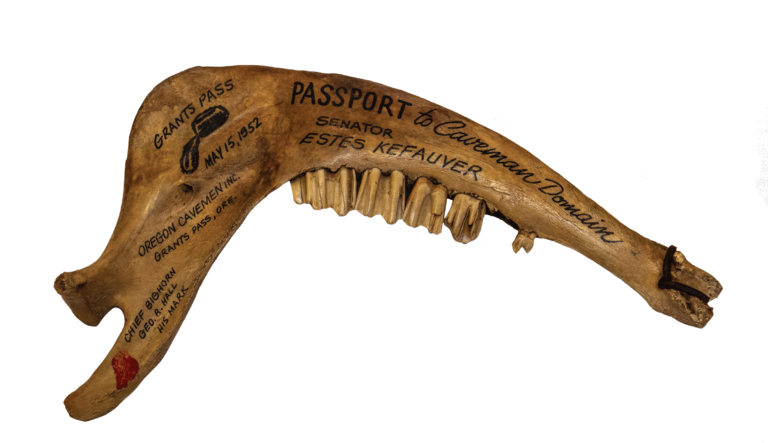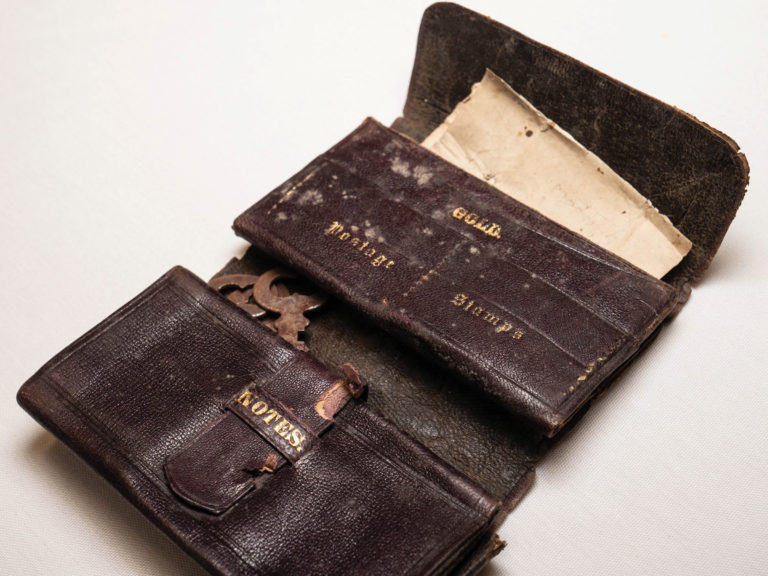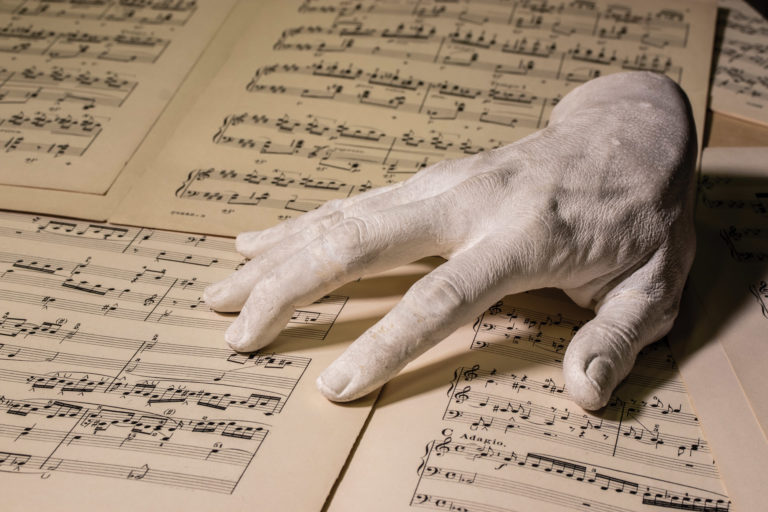By Martha Rudolph | Photos by Shelly O’Barr
Betsey B. Creekmore Special Collections and University Archives builds collections of manuscripts, rare books and other unique materials to support the scholarly interests of the University of Tennessee community, the residents of Tennessee and researchers around the world. Here are a few of the more unusual objects to be found in the UT Libraries’ archives.
Pack of Philip Morris Cigarettes
memento of World War II

Popular culture during World War II glamorized smoking, and the military made cigarettes cheaply available to soldiers. The daily K-ration for combat troops included a four-pack of cigarettes at each meal—breakfast, lunch and dinner. An unopened pack of Philip Morris cigarettes is one of the wartime mementos donated to UT’s Center for the Study of War and Society by the family of World War II Army ordnance officer Edwin Best. Best was a member of the United States Army 6th Engineer Special Brigade, 618th Ordnance Ammunition Company, an amphibious force that participated in the Allied invasion of Normandy at Omaha Beach in June 1944.
Clarence Brown’s
Walking Cane

Legendary Hollywood film director Clarence Brown (1890–1987) enrolled at UT Knoxville at age 15 and, by age 19, had earned degrees in mechanical and electrical engineering. The young engineer’s career path veered from the automobile industry to the burgeoning film industry. After an apprenticeship under silent film director Maurice Tourneur, Brown moved to Hollywood, where he directed many of the great stars of the golden age of motion pictures—Greta Garbo, Lionel Barrymore, Clark Gable and Joan Crawford, among others. He produced seven of Garbo’s films, including her first talkie. Brown’s $12 million bequest to the university built UT’s Clarence Brown Theatre and endowed the theater company. The ornate walking cane is inscribed with Brown’s signature.
Miniature Book
Addresses of Abraham Lincoln

This tiny book—at just under 2 centimeters high, the smallest in the UT Libraries’ collections—includes the unabridged text of the Gettysburg Address. It is one of a set of three tiny volumes of former President Abraham Lincoln’s speeches published in 1929 by the former Kingsport Press to show the skills of the press and its workers. Like any other hardback book, it includes a title page, a dedication, page numbers and even an index.
Button
from a jacket tailored by former President Andrew Johnson

Andrew Johnson, the 17th president of the United States, was a self-made man. He was born in a two-room shack and never attended school. At age 10, he was apprenticed to a tailor and later established a successful tailoring business in Greeneville before entering politics. The button was originally part of a coat that Johnson made while working as a tailor in Greeneville.
Inscribed Jawbone
presented to U.S. Sen. Estes Kefauver

Estes Kefauver, a U.S. senator from Tennessee between 1939 and 1949, was known as a master campaigner with a larger-than-life personality. The collection of Kefauver’s political papers includes the usual examples of campaign memorabilia such as keys to the city—as well as this odd memento from Kefauver’s campaign swing through Grant’s Pass, Oregon, during his 1952 bid for president. The inscribed jawbone (most likely from a cow) was presented to Kefauver by the Grant’s Pass Cavemen. The local booster group was noted for dressing in furs and caveman wigs and performing antics such as initiating politicians into the club.
Dried Flowers
given to Margaret Gray Blanton by Sigmund Freud

Margaret Gray had only a sixth grade education when she married Smiley Blanton in 1910. Her husband’s career as a physician and professor of speech disorders and child development allowed her to take university courses. Over the years, husband and wife co-authored several books. In 1929, Smiley spent several months in Vienna undergoing psychoanalysis with Sigmund Freud. No doubt, this was when Margaret received the flowers, which she dried and saved in a papier-mâché box. Smiley later became a practicing psychoanalyst, and his Diary of My Analysis with Freud was published after the author’s death. Smiley was also the co-founder, along with Norman Vincent Peale, of the American Foundation of Religion and Psychiatry.
J. G. M. Ramsey’s
Wallet

Typical of 19th-century wallets, this example features separate compartments for gold coins, postage stamps and the owner’s spectacles. James Gettys McGready Ramsey (1797–1884) was a Knoxville physician, banker, historian and author of a 700-page book on the history of Tennessee before 1800. During the Civil War, Ramsey supported the Confederacy and served as a Confederate treasury agent. He had a long-standing feud with the pro-Union editor of the Knoxville Whig, William “Parson” Brownlow. One of Ramsey’s sons, who was Confederate States district attorney of Knox County during the war, had Brownlow arrested for treason, and Brownlow was forced into exile. Later, as Tennessee governor, Brownlow ordered Ramsey’s arrest, but Ramsey secured a pardon from President Andrew Johnson. The historic Ramsey House in East Knoxville, now a museum, was the family’s ancestral home.
Plaster Casts
of the hands of three pianists

The manuscript collections include an extensive archive of some 1,500 musical scores assembled by the pianist Gottfried Galston (1879–1950) to document his career and that of his mentor, pianist-composer Ferruccio Busoni (1866–1924). Among the memorabilia are plaster casts of the hands of Galston, Busoni and the 19th-century virtuoso pianist Anton Rubinstein. The practice of making hand casts of famous pianists arose in the 19th century, during the Romantic era of Western classical music. Casts were taken of living pianists and sometimes at the time of death to commemorate a great musician. The cast of Rubinstein’s hand was taken after death.
Moonshine still painted on a
Saw Blade

This scene of a moonshine still was painted with fingernail polish by Sky Sutton, daughter of the near-mythic Smoky Mountain moonshiner Popcorn Sutton. The UT Libraries places a strong emphasis on the history and culture of the region—including resources on the legal and illegal distillation of hard liquor—and the popular culture that has grown up around it. The Moonshine and Distillation Collection includes everything from a 16th-century treatise on the art of distilling spirits to folk art, movie posters and whiskey labels.



